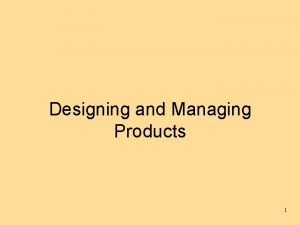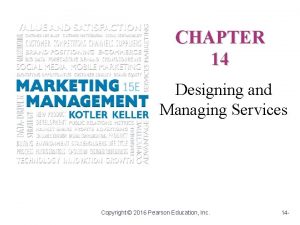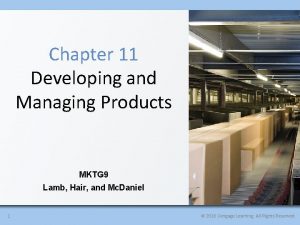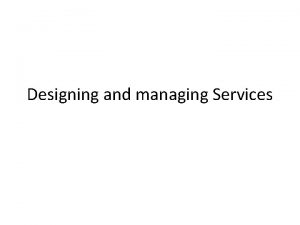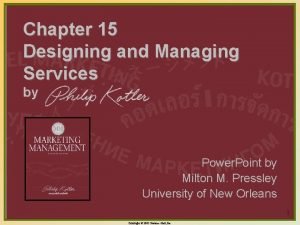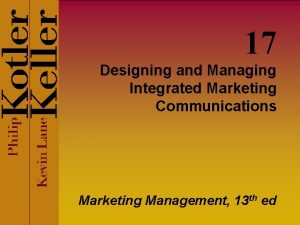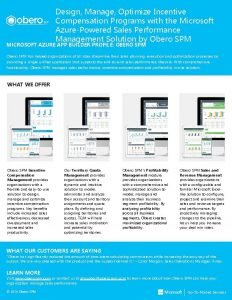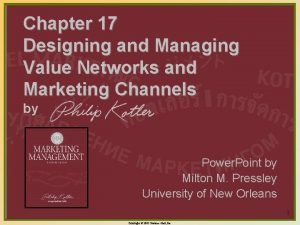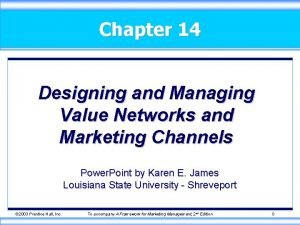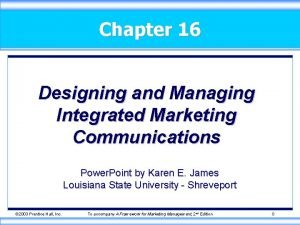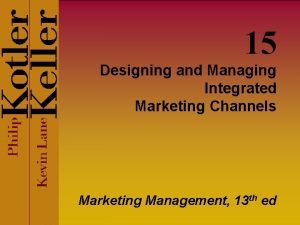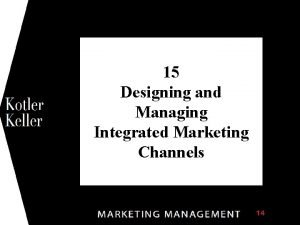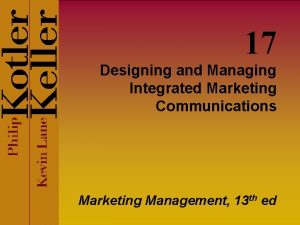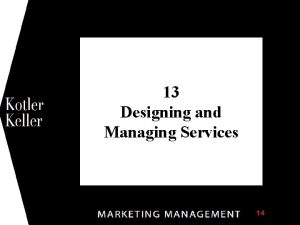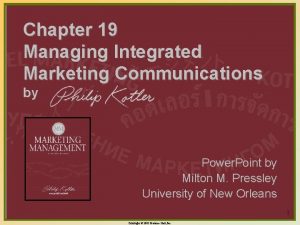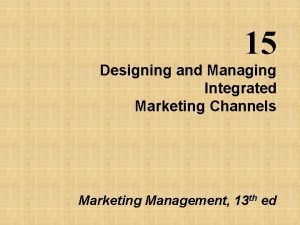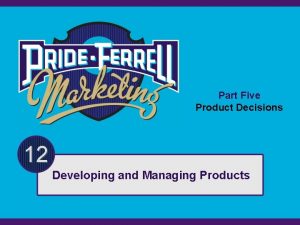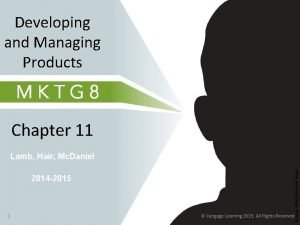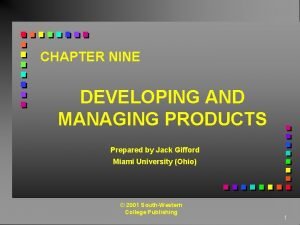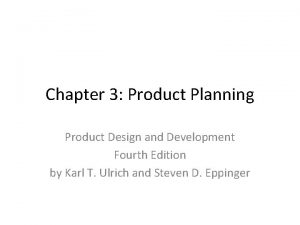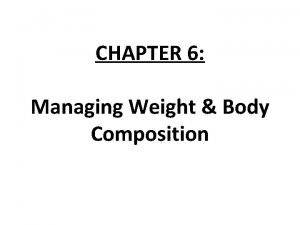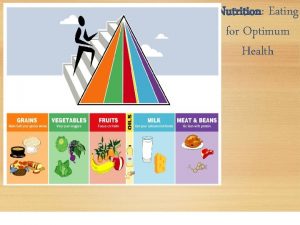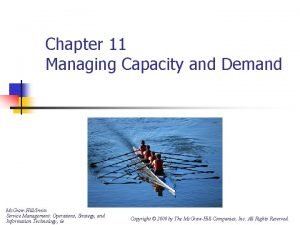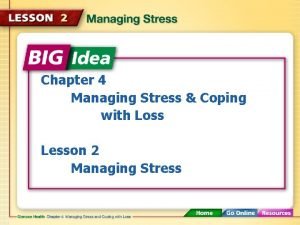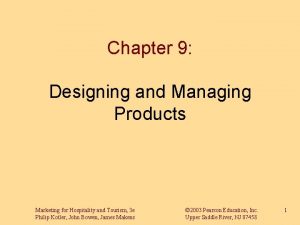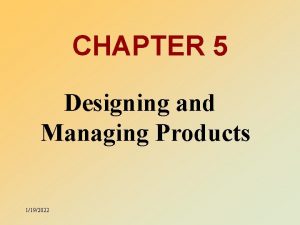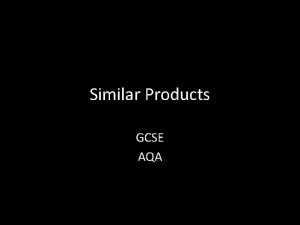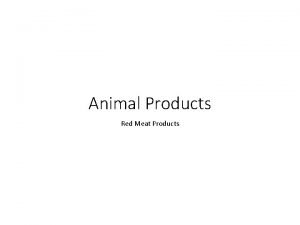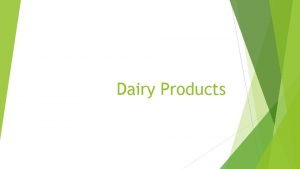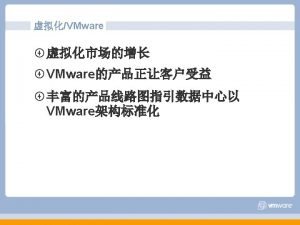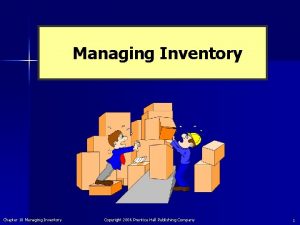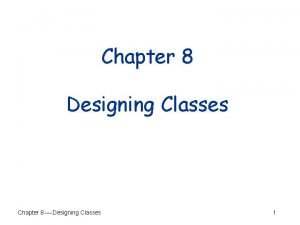Chapter 9 Designing and Managing Products 2006 Pearson










































- Slides: 42

Chapter 9 Designing and Managing Products © 2006 Pearson Education, Inc. Upper Saddle River, NJ 07458 Marketing for Hospitality and Tourism, 4 th edition Kotler, Bowen, and Makens

“Profit is payment you get when you take advantage of change. ” -Joseph Schumpeter “Being fed a decent meal in a casual environment is a commodity in far more supply than demand. ” -Barry M. Cohen © 2006 Pearson Education, Inc. Upper Saddle River, NJ 07458 Marketing for Hospitality and Tourism, 4 th edition Kotler, Bowen, and. Makens

Chapter Objectives • Define the term product, including the core, facilitating, supporting, and augmented product • Explain the elements with which one needs to be concerned when designing a product © 2006 Pearson Education, Inc. Upper Saddle River, NJ 07458 Marketing for Hospitality and Tourism, 4 th edition Kotler, Bowen, and. Makens

Chapter Objectives • Understand branding and the conditions that support branding • Explain the new product development process • Understand how the product life cycle can be applied to the hospitality industry © 2006 Pearson Education, Inc. Upper Saddle River, NJ 07458 Marketing for Hospitality and Tourism, 4 th edition Kotler, Bowen, and. Makens

What is a Product? • A product is anything that can be offered to a market for attention, acquisition, use or consumption that might satisfy a want or need • Includes physical objects, services, places, organizations, and ideas © 2006 Pearson Education, Inc. Upper Saddle River, NJ 07458 Marketing for Hospitality and Tourism, 4 th edition Kotler, Bowen, and. Makens

Product Levels • Core Product • Facilitating Products • Supporting Products • Core Competency © 2006 Pearson Education, Inc. Upper Saddle River, NJ 07458 Marketing for Hospitality and Tourism, 4 th edition Kotler, Bowen, and. Makens

Core Product • What the buyer is really buying • Every product is a package of problemsolving services © 2006 Pearson Education, Inc. Upper Saddle River, NJ 07458 Marketing for Hospitality and Tourism, 4 th edition Kotler, Bowen, and. Makens

Facilitating Products • Goods or services that must be present for the guest to use the core product © 2006 Pearson Education, Inc. Upper Saddle River, NJ 07458 Marketing for Hospitality and Tourism, 4 th edition Kotler, Bowen, and. Makens

Supporting Products • Extra products offered to add value to the core product and help to differentiate it from the competition © 2006 Pearson Education, Inc. Upper Saddle River, NJ 07458 Marketing for Hospitality and Tourism, 4 th edition Kotler, Bowen, and. Makens

Core Competency Review • Supporting products offer a competitive advantage only if they are properly planned and implemented • They must meet or exceed customer expectations to have a positive effect © 2006 Pearson Education, Inc. Upper Saddle River, NJ 07458 Marketing for Hospitality and Tourism, 4 th edition Kotler, Bowen, and. Makens

Augmented Product • The augmented product includes accessibility, atmosphere, customer interaction with the service organization, customer participation, and customers’ interaction with each other. © 2006 Pearson Education, Inc. Upper Saddle River, NJ 07458 Marketing for Hospitality and Tourism, 4 th edition Kotler, Bowen, and. Makens

Product levels (Adapted from C. Gonroos, “Developing the Service Offering— A Source of Competitive Advantage, ” in Add Value to Your Service, C. Surprenant, ed. , Chicago: American Marketing Association, 1987, p. 83. ) © 2006 Pearson Education, Inc. Upper Saddle River, NJ 07458 Marketing for Hospitality and Tourism, 4 th edition Kotler, Bowen, and. Makens

Atmosphere: The Physical Environment • Can be the customer’s reason for choosing, or not choosing, to do business with an establishment • Multidimensional – Visual, aural, olfactory, tactile © 2006 Pearson Education, Inc. Upper Saddle River, NJ 07458 Marketing for Hospitality and Tourism, 4 th edition Kotler, Bowen, and. Makens

Customer Interaction with the Service Delivery System • Joining stage is when the customer makes the initial inquiry contact • Consumption phase takes place when the service is consumed • Detachment phase is when the customer is through using a product and departs © 2006 Pearson Education, Inc. Upper Saddle River, NJ 07458 Marketing for Hospitality and Tourism, 4 th edition Kotler, Bowen, and. Makens

Customer Interaction with Other Customers • Hospitality organizations must manage the interaction of customers to ensure that some do not negatively affect the experience of others © 2006 Pearson Education, Inc. Upper Saddle River, NJ 07458 Marketing for Hospitality and Tourism, 4 th edition Kotler, Bowen, and. Makens

Customer Coproduction • Increase capacity • Improve customer satisfaction • Reduce costs © 2006 Pearson Education, Inc. Upper Saddle River, NJ 07458 Marketing for Hospitality and Tourism, 4 th edition Kotler, Bowen, and. Makens

Brand Decisions • A brand is a name, term, sign, symbol, design, or a combination of these elements that is intended to identify the goods or services of a seller and differentiate them from competitors © 2006 Pearson Education, Inc. Upper Saddle River, NJ 07458 Marketing for Hospitality and Tourism, 4 th edition Kotler, Bowen, and. Makens

Brand • Brands are among a company’s most valuable assets • A Brand represents what the company is and what it stands for • A Brand implies trust , consistency, and a defined set of expectations • The strongest brands own a place in the customer’s mind (Scott Davis, Brand Asset Management) © 2006 Pearson Education, Inc. Upper Saddle River, NJ 07458 Marketing for Hospitality and Tourism, 4 th edition Kotler, Bowen, and. Makens

Branding Consistency Attributes Quality & Value Advantages of Brand Names High Brand Loyalty Name Awareness © 2006 Pearson Education, Inc. Upper Saddle River, NJ 07458 Brand Equity Identification Strong Brand Association Perceived Quality Marketing for Hospitality and Tourism, 4 th edition Kotler, Bowen, and. Makens

Conditions that Support Branding • The product is easy to identify by brand or trademark • The product is perceived as the best value for the price • Quality and standards are easy to maintain © 2006 Pearson Education, Inc. Upper Saddle River, NJ 07458 Marketing for Hospitality and Tourism, 4 th edition Kotler, Bowen, and. Makens

Conditions that Support Branding • The demand for the general product class is large enough to support a regional, national, or international chain • There are economies of scale © 2006 Pearson Education, Inc. Upper Saddle River, NJ 07458 Marketing for Hospitality and Tourism, 4 th edition Kotler, Bowen, and. Makens

Leveraging Brand Equity • Cobranding • Partnerships © 2006 Pearson Education, Inc. Upper Saddle River, NJ 07458 Marketing for Hospitality and Tourism, 4 th edition Kotler, Bowen, and. Makens

New Product Development • Product life cycle – Product is born – Passes through several phases – Eventually dies as younger products come along that better serve consumer needs © 2006 Pearson Education, Inc. Upper Saddle River, NJ 07458 Marketing for Hospitality and Tourism, 4 th edition Kotler, Bowen, and. Makens

New Product Development Process Marketing Strategy Development Concept Development and Testing Idea Screening Idea Generation © 2006 Pearson Education, Inc. Upper Saddle River, NJ 07458 Business Analysis Product Development Market Testing Commercialization Marketing for Hospitality and Tourism, 4 th edition Kotler, Bowen, and. Makens

Idea Generation • Internal Sources • Customers • Competitors • Distributors and Suppliers • Other Sources © 2006 Pearson Education, Inc. Upper Saddle River, NJ 07458 Marketing for Hospitality and Tourism, 4 th edition Kotler, Bowen, and. Makens

Idea Screening • The purpose of screening is to spot good ideas and drop poor ones as quickly as possible © 2006 Pearson Education, Inc. Upper Saddle River, NJ 07458 Marketing for Hospitality and Tourism, 4 th edition Kotler, Bowen, and. Makens

Concept Development and Testing • A product idea envisions a possible product that company managers might offer to the market • A product concept is a detailed version of the idea stated in meaningful consumer terms • A product image is the way that consumers picture an actual or potential product © 2006 Pearson Education, Inc. Upper Saddle River, NJ 07458 Marketing for Hospitality and Tourism, 4 th edition Kotler, Bowen, and. Makens

Concept Development and Testing • The task is to develop an idea into alternative product concepts, determine how attractive each is to customers, and choose the best one • Concept testing occurs within a group of target consumers © 2006 Pearson Education, Inc. Upper Saddle River, NJ 07458 Marketing for Hospitality and Tourism, 4 th edition Kotler, Bowen, and. Makens

Marketing Strategy • Includes information such as the target market and product positioning as well as both short and long term projections in terms of sales, profits and costs © 2006 Pearson Education, Inc. Upper Saddle River, NJ 07458 Marketing for Hospitality and Tourism, 4 th edition Kotler, Bowen, and. Makens

Business Analysis • Business analysis involves a review of the sales, costs, and profit projections to determine whether they satisfy the company’s objectives © 2006 Pearson Education, Inc. Upper Saddle River, NJ 07458 Marketing for Hospitality and Tourism, 4 th edition Kotler, Bowen, and. Makens

Product Development • The prototype must: – Have the key features described in the product concept statement, as perceived by the customer – Performs safely under normal use – Be produced for the budgeted costs © 2006 Pearson Education, Inc. Upper Saddle River, NJ 07458 Marketing for Hospitality and Tourism, 4 th edition Kotler, Bowen, and. Makens

Test Marketing • The product and marketing program are introduced into realistic market settings © 2006 Pearson Education, Inc. Upper Saddle River, NJ 07458 Marketing for Hospitality and Tourism, 4 th edition Kotler, Bowen, and. Makens

Commercialization • In launching a new product, a company must make four decisions: When? Where? To whom? and How? © 2006 Pearson Education, Inc. Upper Saddle River, NJ 07458 Marketing for Hospitality and Tourism, 4 th edition Kotler, Bowen, and. Makens

Product Development Through Acquisition • A method of product development that reduces the risk considerably for large companies that have the assets to purchase and then develop a fledgling chain © 2006 Pearson Education, Inc. Upper Saddle River, NJ 07458 Marketing for Hospitality and Tourism, 4 th edition Kotler, Bowen, and. Makens

Product Life-Cycle Strategies • • • © 2006 Pearson Education, Inc. Upper Saddle River, NJ 07458 Product development Introduction Growth Maturity Decline Marketing for Hospitality and Tourism, 4 th edition Kotler, Bowen, and. Makens

Product Development • Product development begins when the company finds and develops a new product idea • During development, sales are zero and the company’s investment costs add up © 2006 Pearson Education, Inc. Upper Saddle River, NJ 07458 Marketing for Hospitality and Tourism, 4 th edition Kotler, Bowen, and. Makens

Product Life Cycle Sales and Profits Over the Product’s Life From Inception to Demise Sales and Profits ($) Sales Profits Time Product Development Introduction Growth Maturity Decline Losses/ Investments ($) © 2006 Pearson Education, Inc. Upper Saddle River, NJ 07458 Marketing for Hospitality and Tourism, 4 th edition Kotler, Bowen, and. Makens

Introduction • Introduction is a period of slow sales growth as the product is being introduced into the market • Profits are nonexistent at this stage due to high product introduction expenses © 2006 Pearson Education, Inc. Upper Saddle River, NJ 07458 Marketing for Hospitality and Tourism, 4 th edition Kotler, Bowen, and. Makens

Growth • Growth is a period of rapid market acceptance and increasing profits © 2006 Pearson Education, Inc. Upper Saddle River, NJ 07458 Marketing for Hospitality and Tourism, 4 th edition Kotler, Bowen, and. Makens

Maturity • Maturity is a period of slowdown in sales growth because the product has achieved acceptance by most of its potential buyers • Profits level off or decline due to increased marketing outlays to defend the product against competition © 2006 Pearson Education, Inc. Upper Saddle River, NJ 07458 Marketing for Hospitality and Tourism, 4 th edition Kotler, Bowen, and. Makens

Decline • Decline is the period when sales fall off quickly and profits drop © 2006 Pearson Education, Inc. Upper Saddle River, NJ 07458 Marketing for Hospitality and Tourism, 4 th edition Kotler, Bowen, and. Makens

Product Deletion Process (Martin Bell, Marketing Concepts and Strategy, 3 rd ed. , p. 267, 1979, Houghton Mifflin Company; used by permission, Mrs. . Marcellette (Bell) Chapman. ) © 2006 Pearson Education, Inc. Upper Saddle River, NJ 07458 Marketing for Hospitality and Tourism, 4 th edition Kotler, Bowen, and. Makens
 Designing and managing products
Designing and managing products Designing and managing service processes
Designing and managing service processes Chapter 14 designing and managing services ppt
Chapter 14 designing and managing services ppt Developing and managing products
Developing and managing products How to designing and managing service processes
How to designing and managing service processes Designing and managing services
Designing and managing services Designing and managing integrated marketing communication
Designing and managing integrated marketing communication Designing and managing incentive compensation programs
Designing and managing incentive compensation programs Managing channel dynamics
Managing channel dynamics What is a marketing channel system and value network
What is a marketing channel system and value network Designing and managing value networks
Designing and managing value networks Designing and managing integrated marketing communications
Designing and managing integrated marketing communications High value deal seekers
High value deal seekers Integrated marketing channel system
Integrated marketing channel system Amplified expressiveness
Amplified expressiveness Designing and managing services
Designing and managing services Communications mix
Communications mix Designing and managing integrated marketing communications
Designing and managing integrated marketing communications Developing and managing products
Developing and managing products Developing and managing products
Developing and managing products Developing and managing products
Developing and managing products Functional product
Functional product Coke vs pepsi products
Coke vs pepsi products Pearson education 2011
Pearson education 2011 Pearson education inc publishing as pearson prentice hall
Pearson education inc publishing as pearson prentice hall Pearson vue robert whelan
Pearson vue robert whelan Educational pearson pearson times
Educational pearson pearson times Pearson education inc publishing as pearson prentice hall
Pearson education inc publishing as pearson prentice hall 2012 pearson education inc
2012 pearson education inc 2008 pearson prentice hall inc
2008 pearson prentice hall inc Product design planning
Product design planning Chapter 8 managing stress and anxiety
Chapter 8 managing stress and anxiety Leasiest
Leasiest Chapter 6 managing weight and body composition
Chapter 6 managing weight and body composition Most fad diets do follow the mypyramid guidelines.
Most fad diets do follow the mypyramid guidelines. An eating disorder in which people overeat compulsively
An eating disorder in which people overeat compulsively Managers and management chapter 1
Managers and management chapter 1 Chapter 11 managing weight and eating behaviors
Chapter 11 managing weight and eating behaviors Chapter 6 managing weight and body composition
Chapter 6 managing weight and body composition Chapter 11 managing weight and eating behaviors answer key
Chapter 11 managing weight and eating behaviors answer key Chapter 4 managing stress and coping with loss lesson 1
Chapter 4 managing stress and coping with loss lesson 1 Managing capacity and demand chapter 11
Managing capacity and demand chapter 11 Chapter 4 lesson 2 managing stress answer key
Chapter 4 lesson 2 managing stress answer key
